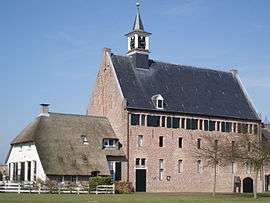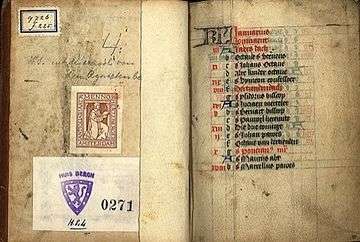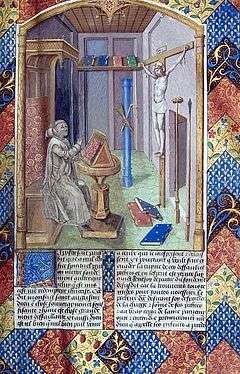Devotio Moderna
Devotio Moderna, or Modern Devotion, was a movement for religious reform, calling for apostolic renewal through the rediscovery of genuine pious practices such as humility, obedience, and simplicity of life. It began in the late fourteenth-century, largely through the work of Gerard Groote,[1][2] and flourished in the Low Countries and Germany in the fifteenth century, but came to an end with the Protestant Reformation.[2] It is most known today through its influence on Thomas à Kempis, the author of The Imitation of Christ, a book which proved highly influential for centuries.[1]
Origins

The origins of the movement probably go back to the Congregation of Windesheim, though it has so far proved elusive to locate the precise origin of the movement.[1] Broadly, it may be seen to rise out of widespread dissatisfaction with the Church (both in terms of the structure of the church and the personal lives of the clergy) in fourteenth-century Europe. Geert Groote (1340-1384) was among many in being highly dissatisfied with the state of the Church and what he perceived as the gradual loss of monastic traditions and the lack of moral values among the clergy. He sought to rediscover certain pious practices.

Devotio Moderna began as a lay movement – around 1374 Groote established his parental house in Deventer into a hostel for poor women who wished to serve God. Though similar to beguine houses, this hostel, and later communities of what came to be called the “Sisters of the Common Life”, were freer in structure than the beguines and kept no private property. The women who lived in these houses remained, also, under the jurisdiction of city authorities and parish priests. Their way of life therefore sat somewhere between ordinary Christian existence ‘in the world’, and the formation of an ecclesiastically recognised religious order.[3]
From this point, several different loose forms of community emerged. On the one hand, various types of life for the female Devout were formed. Especially from the 1390s under the leadership of John Brinckerinck, one of Grote’s early converts, the Sisters of the Common Life spread across the Netherlands and into Germany (with eventually about 25 houses in the former and about 60 houses in the latter). There were also many homes (mostly small and needy) inspired by the movement that were never formally attached to the Sisters of the Common Life, and may eventually have become Third Order Franciscans or Augustinian nuns.[3]
Among male followers, the movement was given impetus after Groote’s death in 1384 by Florens Radewyns (who had become a priest based on Groote's advice). He gathered like-minded laity and clergy into houses of communal living, eventually known as the Brethren of the Common Life, which numbered 41 by the early sixteenth century. The majority of members in these communities were priests or candidates for the priesthood (clerics); the few lay brothers, the familiares, usually carried out the menial tasks of cooking, cleaning and tailoring. These communities did not take vows, but led an austere life of penance, prayer, spiritual reading and work, most often the copying of manuscripts.[3] In addition, the Brethren provided pastoral care and spiritual counsel to the sister houses, and at least some of the Brethren engaged in preaching.
Groote’s message of reform had also been aimed at clerics and priests, some of whom had joined the Brethren. In addition, though, under the leadership of Radewyns, in 1387 some members of the Deventer house set up a new community at Windesheim, near Zwolle, and adopted the habit and rule of St Augustine. Although living a cloistered life under vows, the new community kept many of the practices and spiritual values of the teaching of Groote and Radewyns. From 1395, a monastic union was set up around Windesheim; this new confederation grew quickly, and was joined both by older Augustinian communities (including, famously, Groenendaal in 1413), as well as new foundations, and sometimes the conversion of some of the houses of Brothers to this new form of religious life. By the end of the fifteenth century, there were almost 100 houses (84 of them male) in the Chapter of Windesheim.[3]
The movement faced opposition from clergy and laity at times, both during its early years under Groote’s leadership and under Radewyns’ later expansion. Much of this suspicion was similar to that directed at other new forms of religious devotion developed in the period, such as beguine and beghard movements. Also, the strong resemblance to the monastic life of the daily routine among the Brethren provoked accusations from the mendicant orders that the Brethren and Sisters of the Common Life were starting a new mendicant order, in violation of the Fourth Lateran Council's prohibition of new orders in 1215, and without taking vows.[4] The simplicity and devotion of the Devotio Moderna, though, seems to have lessened the force of many of these criticisms.
It was especially prominent in cities in the Low Countries during the 14th and 15th centuries. Alongside its immediate impact, however, it was the writings of authors associated with the movement (who were most commonly based in the monasteries associated with Windesheim), that gave the Devotio Moderna its wider European influence at the time, and its great subsequent influence.[3]
Decline
In the wake of the Protestant Reformation, the institutions of the Devotio Moderna declined rapidly. In Protestant territories, both the brother houses and the monasteries were dissolved. Most of the houses of the Brethren, including the founding homes of Deventer and Zwolle, had disappeared by 1600. In Roman Catholic areas, some of the brother houses and houses of the Windesheim Congregation survived until they fell victim to the secularisations of the eighteenth and nineteenth centuries. The most important members of the Windesheim Congregation in Germany, St. Marienwolde in Frenswegen, held out until 1809 when the state officially dissolved it. The last canon, Gerhard Tobbe, left Frenswegen in 1815.[5]
The Imitation of Christ
The Imitation of Christ (c. 1418), often attributed to Thomas à Kempis (d. 1471), a Brother of the Common Life, outlines the concepts of Modern Devotion, based on personal connection to God and the active showing of love towards Him (e.g., in the Blessed Sacrament of the altar or during mass). It influenced a number of Saints such as Thérèse of Lisieux and Ignatius of Loyola.
By the late 15th century the advent of the printing press increased the reach of the movement; The Imitation of Christ was printed in several languages by the end of the century.
Techniques for Prayer
The spiritual life of the Devotio Moderna followers was marked by focus on inner devotions and frequent short periods of meditation, especially before each new activity.[2]

The writings of the Devotio Moderna followers such as Gerard of Zutphen and Jan Mombaer, as well as Groote introduced the tradition of "methodical prayer" which arranged exercises day by day and week by week.[6] Groote's On four Kinds of Matter for Meditation included mental imagery, as well as methodical approaches as an element of meditation.[7]
Centuries earlier, Hugh of Saint Victor and Guigo II had produced structured methods for Christian meditation, but their approaches were less systematic.[8][9] The methodical approach of Devotio Moderns towards prayer and meditation found significant following within the Catholic Church, as well as later Reformed communities.[6] The manuals for methodical prayer and meditation by Florens Radewyns and Zutphen had significant influence within Europe for over a century.[10]
The concept of immersing and projecting oneself into a Biblical scene about the life of Jesus was developed by Ludolph of Saxony in his Vita Christi in 1374 and became popular among the Devotio Moderna community.[11] The methods of methodical prayer as taught by the Devotio Moderna entered Spain and were known in the early 16th century, and influenced the approaches to Christian meditation.[12]
Garcias de Cisneros the abbot of the abbey of Montserrat was influenced by the Devotio Moderna and his book Ejercitatorio de la vida spiritual, i.e. "exercises for the spiritual life" became one of the primary sources for the Spiritual Exercises of Ignatius of Loyola.[13][14] Ignatius used both of these techniques in his Spiritual exercises: a methodical format, as well as self-projection into a Biblical scene, e.g. starting a conversation with Christ in Calvary.[11] Also influenced by the Devotio Moderna were Ludovico Barbo, Lawrence Giustiniani and the Canons Regular of San Giorgio in Alga.[15]
However, the methods of "methodical prayer" taught by the Devotio Moderna and the techniques used for "self projection" into the imagery of a Biblical scene (to participate in the life of Jesus), significantly influenced the approaches to Christian meditation in the 16th century and thereafter. These methods persist in meditations such as the Spiritual Exercises, which the Jesuits continue to practice.[11][12]
Influence
Devotio Moderna arose at the same time as Christian Humanism, a meshing of Renaissance Humanism and Christianity, and is related to German mysticism and other movements which promoted an intense personal relationship with God. Practitioners of the Devotio Moderna emphasized the individual's inner life and promoted meditation according to certain strictures. With the ideals of Christian Humanism, Devotio Moderna recommended a more individual attitude towards belief and religion. It is regarded sometimes as a contributing factor for Lutheranism and Calvinism. It was also a significant influence upon Erasmus, who was brought up in this tradition.
References
- Devotio Moderna by John H. Van Engen 1988 ISBN 0-8091-2962-0 pages 7-12
- The Westminster Dictionary of Christian Spirituality by Gordon S. Wakefield 1983 ISBN pages 113-114
- McGinn, p97.
- 'Devotio Moderna', in Jill Raitt with Bernard McGinn and John Meyendorff, eds, Christian Spirituality: High Middle Ages and Reformation, (London: SCM, 1989), p178.
- 'Devotio Moderna', in Jill Raitt with Bernard McGinn and John Meyendorff, eds, Christian Spirituality: High Middle Ages and Reformation, (London: SCM, 1989), p. 179.
- Blessed are the peacemakers: a Christian spirituality of nonviolence by Michael Battle 2004 ISBN 0-86554-871-4 pages 67-71
- Between Saint James and Erasmus: studies in late-medieval religious life by J. van Herwaarden 2003 ISBN 978-90-04-12984-9 page 3
- Christian Spirituality: Origins to the twelfth century, Vol 1 by Bernard McGinn 1986 ISBN 0-7102-0927-4 pages 415-424
- Christian spirituality: themes from the tradition by Lawrence S. Cunningham, Keith J. Egan 1996 ISBN 978-0-8091-3660-5 page 88-94
- A brief history of spirituality by Philip Sheldrake 2007 ISBN 978-1-4051-1771-5 pages 107-108
- Christian spirituality: an introduction by Alister E. McGrath 1999 ISBN 978-0-631-21281-2 pages 84-87
- Teresa of Avila's autobiography by Elena Carrera 2004 ISBN 1-900755-96-3 page 28
- Christian spirituality in the Catholic tradition by Jordan Aumann 1985 Ignatius Press ISBN 0-89870-068-X page 180
- The Study of spirituality by Cheslyn Jones, Geoffrey Wainwright, Edward Yarnold 1986 ISBN 0-19-504169-0, Oxford UP page 337
- "Canons of San Giorgio in Alga". Augustinians Canons. Retrieved 27 May 2014.
Sources
- Bernard McGinn, The Varieties of Vernacular Mysticism, (New York: Herder & Herder, 2012)
Further reading
- Spirituality renewed: Studies on significant representatives of the Modern Devotion. Edited by Hein Blommestijn, Charles Caspers and Rijcklof Hofman (Leuven: Peeters, 2003)
- Elias H. Füllenbach, Devotio Moderna (I. Christianity), in: Encyclopedia of the Bible and Its Reception (EBR), vol. 6 (2013), col. 716-717
- Bernard McGinn, The Varieties of Vernacular Mysticism, (New York: Herder & Herder, 2012)
- Van Engen, John, Sisters and Brothers of the Common Life: The Devotio Moderna and the World of the Later Middle Ages, (Philadelphia: University of Pennsylvania Press, 2008)
See also
- Brothers of the Common Life
- Canons Regular of San Giorgio in Alga
- Christian Humanism
- Christian meditation
- Hendrik Mande
- Imitation of Christ (ideal)
- The Imitation of Christ (book)